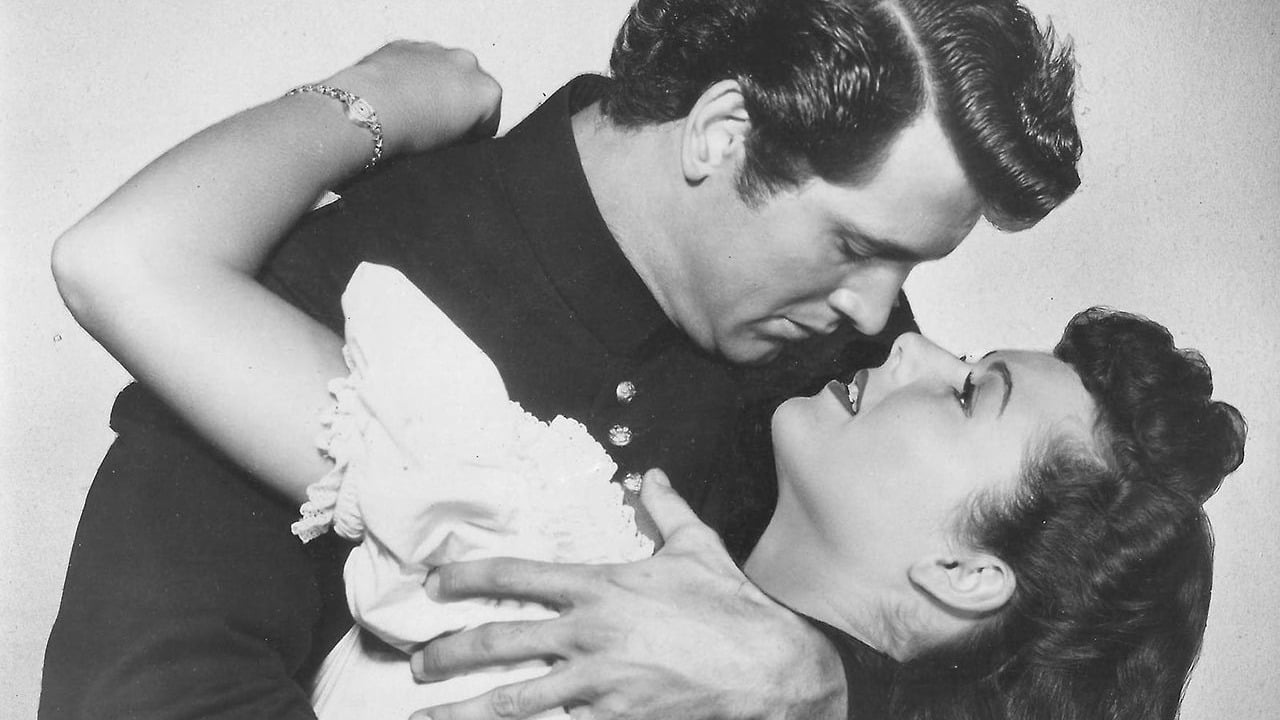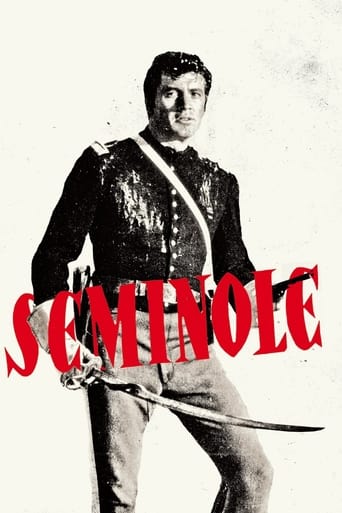

This is very much a Western, except that it takes place in the Everglades. This time they aren't Sioux or Navajo, but Seminoles. But make no mistake...this is pretty much a Hollywood Western. Which is okay...and I still give it some bonus points for taking place during the Seminole Wars...something not covered very much in American cinema.We don't really learn much about Chief Osceola and the Seminole Indian Wars. But what we do see is the personal battle between a commanding officer (Richard Carlson) and his lieutenant (Rock Hudson). And we see the beauty of the Everglades (and yes, much of the film was actually shot in the Everglades), and in stunning color. Anthony Quinn is here as Osceola, but it's not a particularly good role for Quinn. I don't know enough about the real history of this time period in Florida, but I'm sure the film is ridiculously un-historic. Certainly the way they present Osceola dying is totally incorrect. And, while there appear to be Seminole Indians in the cast, all the speaking parts of Seminole Indians are actually white actors with heavy makeup (such as Hugh O'Brian...who is laughable).So, taken with a grain...or maybe a cartload...of salt, it's a good enough Western, and Rock Hudson does nicely here. I'm undecided about Richard Carlson's acting here. It is good to see Barbara Hale in the lead female role; she was a better actress than usually credited. And, they managed to wring out a somewhat happy ending in what was in reality a sad affair.
... View MoreOne thing that can be said without fear of contradiction in this fictionalized but surprisingly balanced story of the Seminole Wars in Florida, is that Richard Carlson as the stern and punctilious Commander of Fort King has never given a more energetic performance.He's hardly recognizable as the thoughtful amateur astronomer of "It Came From Outer Space." His voice seems to have soared to a new octave. He paces back and forth, spitting out his plosives, explaining to the newly arrived Lieutenant Rock Hudson that the Seminoles, previously peaceful, refuse to be relocated to Oklahoma like any reasonable tribe. Instead they've become a "renegade band" under the leadership of Anthony Quinn as Osceola, a real historical figure.Hudson looks a little ridiculous in the Army uniform of 1835 -- that toy soldier hat, those fringe-dripping golden epaulets -- just as all the other soldiers do, just as our soldiers will look to the people of 2135. This is an early performance and it's earnest and artless.Let me anticipate a post-script. First, the Seminole weren't the original inhabitants of the Everglades. They replaced a less sophisticated society called the Calusa, now represented only by buried artifacts and momentous mounds of sea shells. Second, the Seminole are still there and still live in huts called chickees. The Seminole didn't hold with slavery and they were joined by many runaways, which didn't endear the Seminoles to their white neighbors. Now they seem to survive through tourism and by keeping out of the way. When an Eastern Airlines passenger aircraft plowed into the Everglades about 20 years ago, no Seminole showed up in the rescue party. They can hardly be blamed. The Everglades are slowly being drained to provide water for communities elsewhere. It's changing the National Park from swamp to grassland, which seems like a bad idea, but that's just my opinion.Out from behind the lectern and into the movie. It's a product of the 1950s. After a grueling three-day trudge through the swamp, the men remain closely shaved by the studio barber. A clip on the jaw suffices to render a man unconscious for as long as the script requires. The sound track employs cries of the kookaburra, an Australian kingfisher that first was used in "Tarzan and the Green Goddess" (1938), in which Tarzan of the Apes discovers an ancient recipe for salad dressing.The female interest, Barbara Hale, is pretty, wears her hair in a modern style instead of the unsightly loaves of the period. She wears Max Factor and is never without precisely applied lipstick. And her role is a familiar one that has always worked -- she's torn between the uniformed Rock Hudson and their old friend, Anthony Quinn, who now leads his tribe in the swamp. Hudson is a tall, handsome white man. Quinn is a poor, proud, impassioned half-Indian. Guess who gets her.If you've seen John Ford's "Fort Apache" (1948) you'll have a decent idea of the plot. Martinet (Henry Fonda) wants war; younger officer (John Wayne) tries to discourage him.
... View MoreSeminole is a tale of those Indian Wars the United States fought with the native tribe of Florida and of their charismatic chief and martyr Osceola. Although Rock Hudson and Barbara Hale starred, the real star of the film and one who would have made a great Osceola had the real story been told was Anthony Quinn.One thing that is true was that Osceola was of mixed heritage. Hudson plays a newly minted US Army lieutenant who is from Florida and assigned back there to do scouting for Major Richard Carlson commander of Fort King. The Seminoles are hostile now as they've not been before, with good reason considering President Andrew Jackson's Indian removal policy. They're not about to let happen to them what happened to the Choctaws, Cherokees, and Creeks to the north.Quinn and Hudson knew each other as kids and both are rivals for Barbara Hale who serves as an intermediary. If a peaceful settlement of things were ever possible, it won't be because Richard Carlson, a spit and polish martinet is looking for military glory. Carlson really chews the scenery here, he should have dialed it down a bit.In one respect the film is daring, showing an interacial romance between Hale and Quinn. Hudson is distinctly second fiddle to Quinn in his pursuit of Hale.The story is told in flashback by Hudson at an army court martial presided over by Zachary Taylor played by Fay Roope. Although Osceola died in army custody, the facts here are totally wrong. He was tricked into captivity and was transported to Fort Moultrie in South Carolina where he died. I won't tell the story of the film, but do know that this ain't the way it happened. They've got the year wrong, Osceola died in 1838 and the film at the beginning identifies the time as 1835. Also the army is firing revolvers, not yet invented by Samuel Colt, though director Budd Boetticher spotted that one and he carefully edited the movie so as not to show anyone firing more than once. The cap and ball was still in use then. Budd Boetticher took some time away from working with Randolph Scott and he would have been a good director to have told the real story of Osceola. He and Quinn would have made a great team.
... View More"Seminole" is set at Fort King, in the Florida, territory of 1835, where West Pointer Lieutenant Hudson is charged with the murder of a sentry...At the court-martial he recounts his story: the wary co-existence between the settlers and the Indians was threatened by the strict commander (Richard Carlson) of the Army fort... Hudson's childhood sweetheart, Barbara Hale, agreed to meet with Osceola (Anthony Quinn), a mutual friend from their youth who had given up his own Army career to become chief of the Seminole tribe...Through her influence and Quinn's respect for Hudson, the redskin leader eventually comes to the stockade under a truce flag... But Indian-hating Carlson imprisons Quinn in a detention pit, the latter dies, and the situation deteriorates from bad to worse until the Indians rescue Hudson, who had been jailed by Carlson for killing a soldier while trying to restore peace...All the cast of the film (photographed in Technicolor) gives energetic performances... Barbara Hale's major asset is her physical presence, providing a tone of sincerity... Anthony Quinn plays the noble 'savage' for the last time...
... View More